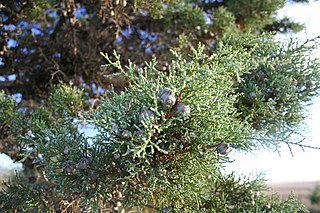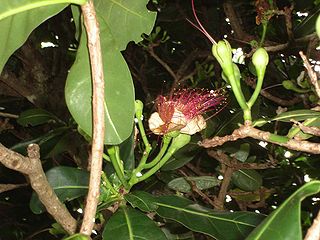
Felidae is a family of mammals in the order Carnivora, colloquially referred to as cats. A member of this family is also called a felid. The term "cat" refers both to felids in general and specifically to the domestic cat.

The IUCN Red List of Threatened Species, founded in 1965, has evolved to become the world's most comprehensive inventory of the global conservation status of biological species. It uses a set of criteria to evaluate the extinction risk of thousands of species and subspecies. These criteria are relevant to all species and all regions of the world. With its strong scientific base, the IUCN Red List is recognized as the most authoritative guide to the status of biological diversity. A series of Regional Red List are produced by countries or organizations, which assess the risk of extinction to species within a political management unit.

Cypress is a common name for various coniferous trees or shrubs of northern temperate regions that belong to the family Cupressaceae. The word cypress is derived from Old French cipres, which was imported from Latin cypressus, the latinisation of the Greek κυπάρισσος (kyparissos).

A least concern (LC) species is a species which has been categorized by the International Union for Conservation of Nature (IUCN) as evaluated as not being a focus of species conservation. They do not qualify as threatened, near threatened, or conservation dependent.

Millettia laurentii is a legume tree from Africa and native to the Republic of Congo, the Democratic Republic of Congo, Cameroon, Gabon and Equatorial Guinea. The species is listed as "endangered" in the IUCN Red List, principally due to destruction of its habitat and over-exploitation for timber. Wenge, a dark colored wood, is the product of Millettia laurentii. Other names sometimes used for wenge include African rosewood (ambiguous), faux ebony, dikela, mibotu, bokonge, and awong. The wood's distinctive color is standardised as a "wenge" color in many systems.

A species that is extinct in the wild (EW) is one that has been categorized by the International Union for Conservation of Nature as known only by living members kept in captivity or as a naturalized population outside its historic range due to massive habitat loss.
Juniperus angosturana is a species of conifer in the Cupressaceae family.
Juniperus gamboana is a species of conifer in the Cupressaceae family. It is found in Guatemala and Mexico. It is threatened by habitat loss.
Juniperus komarovii is a species of conifer in the Cupressaceae family. It is found only in China.

Juniperus monticola, or Mountain juniper, is a species of conifer in the family Cupressaceae. It is found only in Mexico.

Juniperus saltuaria is a species of conifer in the Cupressaceae family. It is endemic to southern China and Tibet. The trees grow up to 20 metres (66 ft) high.

The dragon tube-nosed fruit bat is a species of bat in the family Pteropodidae. It is found on both sides of New Guinea: West Papua, Indonesia and Papua New Guinea. It is slightly smaller and very similar in appearance to N. albiventer, differing by having more profuse, dark spotting on its wing membranes, and smaller shorter canines. The similarity between the species has been a source of possible misidentifications. The records of this species from Papua New Guinea are associated with freshwater swamps and rivers.
Rhaptopetalum is a genus of plants in the family Lecythidaceae.
Rhaptopetalum belingense is a species of plant in the family Lecythidaceae. It is endemic to Gabon.
Rhaptopetalum geophylax is a species of plant in the family Lecythidaceae. It is endemic to Cameroon. Its natural habitat is subtropical or tropical moist lowland forests. It is threatened by habitat loss.
Rhaptopetalum sindarense is a species of plant in the family Lecythidaceae. It is endemic to Gabon.
Terminalia ivorensis is a species of tree in the family Combretaceae, and is known by the common names of Ivory Coast almond, idigbo, black afara, framire and emeri.
Turraeanthus africana is a species of plant in the family Meliaceae, also known by the common names avodiré, apeya, engan, agbe, lusamba, wansenwa, African satinwood, and African white mahogany.

In computing, a Digital Object Identifier or DOI is a persistent identifier or handle used to identify objects uniquely, standardized by the International Organization for Standardization (ISO). An implementation of the Handle System, DOIs are in wide use mainly to identify academic, professional, and government information, such as journal articles, research reports and data sets, and official publications though they also have been used to identify other types of information resources, such as commercial videos.












